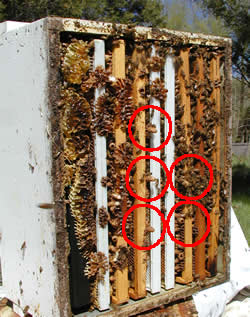|
THE SWARM PROCESS-
START TO FINISH:
- In the early spring,
(March here in Idaho) the bees start raising Drones (male bees) which
have not been present in the hive all winter. Since the male bees contribute
nothing to the survival of the hive over the winter, they are expelled
by the worker bees in early fall to starve and die outside of the hive.
- As the bee population
increases in late March and April worker bees start building "queen
cups" on the bottom of the brood frames. As shown, these form the
beginning of what will eventually be a queen cell. This is the first
step in preparation for ensuring a replacement queen when the swarm
leaves.
- As the weather
gets warmer, the honey from the spring flowers comes in, the hive gets
more crowded and the bees decide it's time - the queen will lay eggs
in most or all of the queen cups. Once the eggs are laid, the queen
cells will be nursed by the workers and grow to hatch new virgin queens
in about 12 days. Photos at right show queen cell development. Once
eggs are laid in the queen cups, the swarm will usually depart the hive
during this 12 day period.
- Bees usually swarm
on a sunny warm day. On the big day, swarm bees start clustering outside
the hive in late morning. In the heat of the afternoon, the queen emerges
and starts her flight while the swarm of bees follow. It's an amazing
sight to see - it looks like a big black cloud moving through the air!
- This is the first
of two moves the swarm will make. They don't go very far from the hive
on this flight - usually only a few hundred yards before they light
on a tree or fence post or other spot out in the open (above). The cluster
will hang (literally) at this chosen spot for a few hours to several
days until they find a new home. While the swarm waits, scout bees search
the area up to a mile away looking for a cavity of some sort with a
small entrance the bees can protect for their new home. It could be
a hollowed out tree, a wall in a house or other enclosure with a restricted
entrance from which the bees can come and go.
- Once the scout
bees find the right home, they communicate the location to the others
by a waggle dance conveying distance and direction to the other bees.
Waggle dance communication goes on all the time in the hive but watching
a swarm while it hangs on a limb is a rare opportunity to see it with
an unobstructed view.
- When the scouts
have located the new home, the swarm makes the final flight to their
new location where they immediately start setting up by building beeswax
comb, gathering honey followed by the queen laying her eggs to produce
future workers to grow the colony.
- Meanwhile, back
at the original hive jealous new queens are emerging from the queen
cells. Queen bees will not tolerate another queen in the hive, so something
has to give. The queens may fight it out until there's only one left
- natures selection process at work. Often, one queen hatches prior
to the others, providing the first with the opportunity kill the others
before they emerge. Queens, unlike worker bees do not lose their stingers
when they sting and this "multi-use" stinger is for just this
purpose. On other occasions, one or more of the virgin queens will depart
the hive in a secondary swarm to establish yet another new colony
|

|










